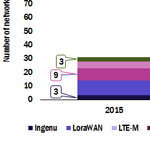Seems LoRa is really taking off. Citing data from research firm Analysys Mason, Chris Donkin writes that 85 new networks were announced as live, in a trial phase or in development in 2016 compared with 29 in 2015.
While early LPWA deployments were concentrated in the US and Western Europe, Analysys Mason found interest in the technology spread during 2016, with strong traction being seen in the APAC market.
During 2015, two thirds of initiatives took place in the US and Western Europe whereas in 2016 the figure was down to less than a third. Simultaneously APAC showed growth from 4 per cent in 2015 to 30 per cent in 2016.
The report identified developments in Japan, Singapore, South Korea, Australia and New Zealand as being especially significant in the regional shift identified last year.
– via Mobile World Live
While a lot of these led by SigFox or operators using the NB-IoT standard — a stripped down 3G, more interesting, I think is the LoRa version, which actually provided the single largest group — 29 deployments vs 27 Sigfox.
The LoRa Alliance says 17 nationwide deployments have been publicly announced, and there are live networks in more than 150 cities. So I’m guessing AM’s numbers are somewhat conservative. The Things Network, an open source implementation of LoRa, boasts dozens of communities — people who are working on networks, however small — and while most are in Europe and the US, Australia is strong — Sydney’s Meshed Network Pty has installed five gateways around the city.
The author of the AM piece, Aris Xylouris, says “we can expect more announcements to be made before Mobile World Congress (MWC) 2017. It is likely that the launch of the first real commercial deployment of an NB-IoT network will be among the announcements at MWC 2017.”
Here’s my take from August on narrowband.

